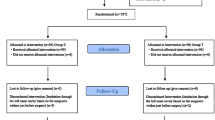Summary
Eighty patients having anaesthesia for oral surgery requiring nasal intubation were randomly allocated to be intubated with either a plain Magill red rubber or cuffed polyethylene endotracheal tube and in a double blind manner, to receive xylometazoline 0.1% vasoconstrictor nasal spray. The extent of any epistaxis occurring was assessed by an independent observer. With the Magill tube there was bleeding in one out of twenty patients in both the vasoconstrictor group and non vasoconstrictor group at intubation and no bleeding in either of the two groups at extubation. With the polyethylene tube sixteen out of twenty patients had bleeding in the non vasoconstrictor group. This improved to seven out of twenty with the administration of vasoconstrictor drops at intubation (chi square 10.2; p<0.01) in the polyethylene tube group. At extubation ten out of twenty patients had bleeding in the non vasoconstrictor group improving to two out of twenty with the administration of the vasoconstrictor (chi square 9.6; p,0.01). The use of the vasoconstrictor xylometazoline helped to reduce epistaxis that occurred during nasal intubation and further study into the type of endotracheal tube is recommended.
Similar content being viewed by others
References
Rector, F. T. R., Denuncio, D. J., Aiden, M. A. A comparison of cocaine, oxymetazoline and saline for nasotracheal intubation. Journal of the American Association of Nurse Anesthetists 1987; 55: 49–54.
Magill, I. N. Technique in endotracheal anaesthesia British Medical Journal 1930; 2: 817.
Verlander, J. M., Johns, M. E. The clinical use of cocaine 1981. Otological clinics of North America 1981; 14: 521–31.
Smith, R. B. Cocaine and catecholamine interaction: A review. Archives of Otolaryngology 1973; 98: 139–41.
Katz, R. I., Hovagim, A. R., Finklestein, H. S., Grinberg, Y. R., Boccio, R. M., Popperes, P. J. A comparison of cocaine, lidocaine with epinephrine, and oxymetazoline for prevention of epistaxis on nasotracheal intubation. Journal of Cinical Anesthesia 1990; 2(1): 16–20.
Cole, P., Haight, S. J., Cooper, P. N., Kassel, E. E. A computerised tomogram study of nasal mucosa: effects of vasoactive substances. Journal of Otolaryngology 1983; 12(1): 18–60.
Cooper, R. Bloodless turbinectomy following blind nasal intubation. Anesthesiology 1989; 71: 469.
Harmer, M. Difficulties in tracheal intubation in complications of tracheal intubation. Edited by Latto, I. P., Rosen, M. Bailliere Tindall; 1984:3 6-40.
Author information
Authors and Affiliations
Rights and permissions
About this article
Cite this article
O’Hanlon, J., Harper, K.W. Epistaxis and nasotracheal intubation - prevention with vasoconstrictor spray. I.J.M.S. 163, 58–60 (1994). https://doi.org/10.1007/BF02943016
Issue Date:
DOI: https://doi.org/10.1007/BF02943016




